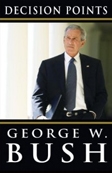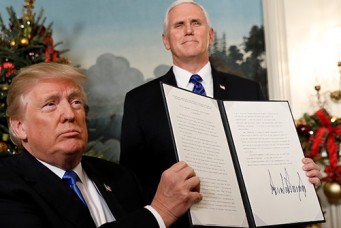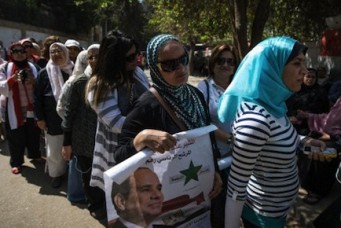Decision Points
Assessing the president from Texas.
Decision Points. By George W. Bush. Crown Publishers, 2010. 512 pp.
A few months ago, I interviewed a prominent member of George W. Bush’s cabinet for a forthcoming book on American diplomacy in the Middle East.* I focused a question about the influence and the apparent change over time of former Vice President Dick Cheney. This member of Bush’s cabinet, who had worked closely with Cheney in more than one administration, disputed the idea that Cheney had changed over the years. What explains the seemingly different approaches that Cheney exhibited in the administrations of Bush and of his father, George H. W. Bush, he suggested, is above all else the differences between the two presidents. In other words, he said, I should be asking about George W. Bush, not Dick Cheney. Decision Points promised to shed desperately needed insight into the thought process of a man whose decisions affected world politics more than any other in the past decade.
Bush has penned a readable, thematically organized memoir covering issues ranging from the Katrina disaster to the financial crisis, which demonstrates the sort of traits that made him likable to so many Americans even as he was disliked, even despised, in other parts of the world. But the book is revealing in other ways that confirmed the worries many had about his decisions as the American commander in chief: there is an extraordinary absence of introspection on some of the most complex and challenging issues, and a portrayal of a decisiveness based on personal judgment.
One is left with the same impression that many analysts held during his years in office: Bush tends to make up his mind early, with only limited deliberation, usually based on instinct, and the hard work of the bureaucracies, the national discourse, the international consultations, was about selling and rationalizing what the president had already decided.
The trend starts with his decisions to appoint top advisors and his subsequent relationships with them. In his book, Bush reveals that after he won the Republican primaries the first time he ran for president in 2000, his first choice for a vice-presidential running mate, even before he put together a search and vetting committee, was Cheney, whom he had sounded out for the position only to be turned down. It was then that he turned to Cheney to head the search for a vice-presidential nominee. And despite a number of good candidates that Cheney presented to him, he dismissed most of them one by one. He came close to picking John Danforth, for whom he expressed nothing but admiration, before going back to his original choice. Cheney by then appeared more interested in the job, but worried that his health (and his gay daughter) could become political liabilities. Bush’s key advisor, Karl Rove, originally opposed the idea and presented some good arguments against it. Most prominently, he worried that “choosing Dad’s defense secretary would make people question whether I am my own man” and that Cheney added little to the ticket politically. But Bush had clearly made up his mind.
Still, in much of the book, Bush appears mindful of how his relationship with his father is portrayed and how the prevalent view that Cheney ran the White House was an issue he had to grapple with, and he tries hard in the book to dispel it. On one occasion, Bush tells of asking his national security advisor to convey to the vice president his displeasure that Cheney had moved ahead of him in his public statements on Iraq. He also describes how he considered dropping Cheney from the ticket in 2004, at Cheney’s suggestion, as there was a sense that Cheney had become a political liability—and also as a way of dispelling the conventional wisdom that Cheney, not Bush, was running the White House.
The influence of ‘Dad’ is ever present in Decision Points, sometimes directly, sometimes in subtle ways. Even as he sought to differentiate his administration from that of his father’s, Bush often sought his father’s advice and backing. When he decided to choose Cheney as a running mate, his father’s approval was sought and received. When he gave the orders to commence the war with Iraq, he sent a handwritten note informing his father, who wrote back movingly, “You carry the burden with strength and grace… Remember Robin’s words ‘I love you more than the tongue can tell’”—a reference to a sister of the younger George Bush who died of leukemia. When Brent Scowcroft, the respected former national security advisor to Bush Sr., wrote an op-ed in The Wall Street Journal opposing the Iraq war, Bush was angered not only by the fact that he went to the press rather than to Bush directly, but also by the fact that people assumed that Scowcroft was speaking for the president’s father, which George W. Bush denied vehemently. He called his father to vent his anger at Scowcroft’s article.
One of the more revealing chapters in the book concerns personnel decisions. What comes across is a tendency to make personal and highly instinctive decisions on critical appointments. He recounts that former British Prime Minister Margaret Thatcher told him she usually made up her mind about a man in ten seconds. “I didn’t operate quite that fast,” Bush writes, “but I’ve always been able to read people.” Besides his early decision on Cheney, his selection of Condoleezza Rice, as his national security advisor, with whom he had spent some time during the campaign—having been introduced to her by his father—was also quick, giving no indication of a full assessment of alternative candidates. He reveals that the appointment of Donald Rumsfeld as defense secretary was suggested to him by Rice, and enthusiastically endorsed by Cheney who had worked for Rumsfeld in the Ford White House.
His treatment of his relationship with Colin Powell is most telling. Bush, who turned to Powell for his first major cabinet appointment, notes that “Colin was widely admired at home and had a huge presence around the world. I believed Colin could be the second coming of George Marshall, a soldier turned statesman.” But by the time Powell decided to leave the administration, Bush remarked that Powell’s decision “made it easy for me . . . I admired Colin, but it sometimes seemed like the State Department he led wasn’t fully on board with my philosophy and policies.” In between, he took a few shots at the decorated general. He recounts instructing Rice to tell Powell to correct a statement the latter had made to the Washington Post about North Korea, even as Powell was on his way to see the president at the White House. In another instance, he tells of Powell passing him a note before he made a speech after the September 11, 2001, attack, suggesting ways to avoid becoming emotional, only to have Bush announce to everyone present that “the secretary of state just told me . . . ‘Dear Mr. President: Don’t break down!’” Referring to another occasion when Bush and his advisors heard what turned out to be a false alarm about possible exposure of the White House to a highly poisonous toxin, Bush writes that “Colin asked, ‘What’s the time of exposure?’ Was he doing the mental math, trying to figure out how long it had been since he was last in the White House?” In a final jab at the man who remained more popular than the president throughout the Bush administration, Bush tells that his advisors suggested after his reelection that Powell was having a change of heart about leaving his post—but the president clearly showed no interest in wooing him back.
On the core foreign policy issues following the 9/11 tragedy—the ‘war on terrorism,’ the Iraq war, the Palestinian–Israeli conflict—the story Bush tells is remarkably close to the rhetoric of the period. There is a puzzling absence of discussion of the internal debate or even a full assessment of consequences, with selective memory only partially explained by the organization of the book, which is not chronological but issues-based. There is a glaring absence of lessons learned, of reflection on mistakes, which could inform future presidents. One is left with the conclusion that Bush believed almost all that he said while president.
His thoughts and decisions on how to deal with terrorist threats provided a clear example of his consistent positions now and then—and the basis of these decisions: “There is no textbook on how to steady a nation rattled by a faceless enemy. I relied on instincts and background.” So he announced “a major decision I had made: The United States would consider any nation that harbored terrorists to be responsible for the acts of those terrorists. This new doctrine overturned the approach of the past, which treated terrorist groups as distinct from their sponsors.” And yet Bush gives no indication of what sort of thought process he followed in pursuing what he believed was a radical change in policy, or any sense of the internal debates about the issue. We know, for example, that the U.S. Department of State had favored confronting terrorist groups ‘with global reach’ instead of a broader ‘war on terrorism.’ And when Bush gives an example of reservations put forth by former Senate Democratic Majority Leader Tom Daschle, the example only serves to suggest that Bush’s decision was again based on instinct and personal judgment: “Daschle . . . issued one cautionary note. He said I should be careful about the word war because it had such powerful implications. I listened to his concerns, but I disagreed. If four coordinated attacks by a terrorist network that had pledged to kill as many Americans as possible was not an act of war, then what was it? A breach of diplomatic protocol?”
It is also clear that 9/11 and Bush’s formulation of the ‘war on terrorism’ colored his approach to the Palestinian–Israeli conflict. To begin with, Bush accepted conventional wisdom about the failure of the Camp David negotiations a few months before he took office: Palestinian leader Yasser Arafat was to blame. And he saw Israel as a democratic state that exists within vulnerable boundaries that he had been shown from a helicopter by Ariel Sharon even prior to becoming president. Before he held his first cabinet meeting after the 9/11 attack, he had a phone call with Sharon, who had become prime minister, “a leader who understood what it meant to fight terror.” But his biggest break with Arafat came in January 2002, when the Israeli navy intercepted a ship called the Karine A in the Red Sea with an arsenal of deadly weapons on board. While Arafat denied involvement, Bush says that the United States had information proving otherwise. That marked the end of the relationship with Arafat.
In a telling episode, Bush decided to give a speech that simultaneously favored the establishment of a Palestinian state (which was opposed by Cheney and Rumsfeld), and also called for a change of Palestinian leadership (which was opposed by Powell). Only Rice and her deputy, Stephen Hadley, supported the idea of the speech. But the headlines after the speech predictably highlighted Bush’s call for replacing Arafat—so much so, Bush writes, that the president’s mother called to rib him: “‘How’s the first Jewish president doing?’ she asked. I had a funny feeling she disagreed with my policy.”
These details were largely known about Bush’s position and very much coincided with the public approach he took at the time. But on two key relationships for the president in the Middle East—with Sharon, and with then Crown Prince Abdullah bin Abdulaziz Al-Saud of Saudi Arabia–we get one-dimensional accounts that fail to describe the complexity of dealing with either. With the former, Bush describes an episode where he failed to restrain Sharon, but offers little comment; and with the latter he suggests that he was able to defuse the anger of the Saudi crown prince at Bush’s failure to restrain Sharon simply by taking him for a ride on his farm, as if substance was simply a side story.
The remarkable story is that of the Iraq war. There is little indication here of any serious sense of failure or partial remorse, even with regard to the U.S. failure to discover weapons of mass destruction—a principal justification for the invasion—after the toppling of Iraqi leader Saddam Hussein. One certainly cannot expect Bush to embrace the world view of those who opposed the war or even to accept the prevailing conclusion that the war was unnecessary and the outcome troubling, at least in terms of the costs (both for Iraq and for the United States), the empowerment of Iran, and the failure to spread democracy. But one does expect more evidence of deliberation over painful choices and trade-offs, more insight into the failure of intelligence—and in some instances the doctoring of intelligence—and more reflection on the lessons for future decision makers. Instead we have mere repetition of the types of argument that the Bush administration had made before, most of which focused on Saddam himself.
“[Initially]. . . my policy focused on tightening the sanctions… Then 9/11 hit, and we had to take a fresh look at every threat in the world. There were state sponsors of terror . . . Saddam Hussein didn’t just sympathize with terrorists. He had paid the families of Palestinian suicide bombers and given sanctuary to terrorists . . . Saddam Hussein didn’t just pursue weapons of mass destruction. He had used them.” The fact that it was Al-Qaeda, not a Palestinian group, that attacked American soil, and that this terrorist organization did not exist in Iraq before the war, but established a base there after the war, is not part of the story Bush tells.
The president’s decision seemed simple enough: “We cannot allow weapons of mass destruction to fall into the hands of terrorists. I will not allow that to happen.” In this view one cannot wait for evidence of the full danger: “The lesson of 9/11 was that if we waited for a danger to fully materialize, we would have waited too long. I reached a decision: We would confront the threat from Iraq, one way or another.” For Bush, it is as if these are self-evident axioms that require no debate.
One can speak of the role of neoconservatives, of Cheney and Rumsfeld, of the many staffers who clearly helped make the case for the war, but in the end it was about a president who operated first and foremost on the basis of instinct and who was clear in his own mind about what he wanted to do. This is not to underestimate the influence of many of his advisors, including the neoconservatives who were particularly strong advocates of war with Iraq even before 9/11. But I have always believed that the decision to go to war was Bush’s own instinct, not a product of the lobbying of neoconservatives, and that the power of this group, inside and out of government, was merely enhanced by its support for a president whose own instinct was to go to war. Once the president made up his own mind, neoconservatives became his biggest allies inside government and in the public discourse—and in that role, their overall power in the Bush administration expanded. Still, the manipulation of the information within the system, as well as its reinforcement of the president’s own views, was undoubtedly a factor in encouraging the president to go all the way.
In the end, Decision Points is a frustrating, somewhat depressing book—and not because it is unclear; it is accessible and occasionally humorous. But one is left with the same judgment that one started with: either Bush is simply telling a political story that plays well to a public which had turned against him by the time he left office—with some success, given how briskly the book is selling—or he is as unreflective as he comes across. For those of us who understood from the outset that American presidents make a big difference in the conduct of foreign policy, particularly in time of national crises, and that George W. Bush became super-empowered by the tragedy of 9/11, when his own instincts and judgments were central to the critical policies his administration pursued for the next seven years, there was hope that the book would shed some light on the thinking of a man whose ideas and decisions were surely more complex than the sloganeering of his administration. In this book, George W. Bush tells us that what you saw and heard is really what you got.
*The interview, conducted in Arlington, Va., was on the record but without attribution. It was part of the research for a book on American diplomacy toward the Arab–Israeli conflict, 1989–2009, co-authored with Daniel C. Kurtzer, Scott B. Lasensky, William B. Quandt, and Stephen L. Spiegel.
Shibley Telhami is the Anwar Sadat Professor for Peace and Development at the University of Maryland and a non-resident senior fellow at the Saban Center at the Brookings Institution. He has authored or edited numerous books, including The Stakes: America and the Middle East, Power and Leadership in International Bargaining: The Path to the Camp David Accords, International Organizations and Ethnic Conflict, and Identity and Foreign Policy in the Middle East. He was a member of the U.S. Advisory Group on Public Diplomacy in the Arab and Muslim World and served on the Iraq Study Group. He is a member of the Council on Foreign Relations and serves on the board of the Education for Employment Foundation.





